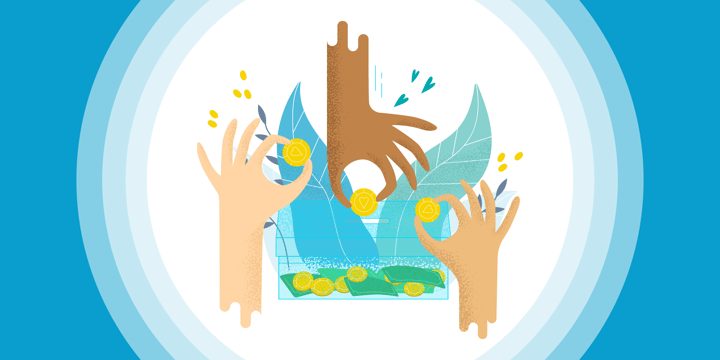If you've been feeling stuck with fundraising strategies that don't quite seem to cut it anymore, you're not alone. Just as our technologies require periodic updates, so, too, do our broader fundraising strategies.
Nonprofit organizations of all sizes generally run a tight ship. Insufficient budgets and high-intensity campaigns mean that most nonprofits like to stick with what has worked in the past. But a lot can change, relatively quickly, in the fundraising world.
For example, look at telethons or cold calling; they were once reliable fundraising tactics for organizations of all kinds. But today, millennial and Generation Z donors tend to not even bother answering calls from unknown numbers, and why should they? Non-urgent communication has almost completely shifted to email and text messaging.
The point? Your nonprofit's fundraising strategies have to keep pace with constantly changing technologies and donor preferences — even when the prospect of investing precious time and resources in new tools is enough to ruin your week.
At DNL OmniMedia, we help nonprofits make the most of their digital assets. Regardless of which part of your fundraising strategy could use an upgrade, there are always steps your organization can take to improve its ability to both raise money and engage donors. And sometimes the steps are simple.
Let's take a closer look at some of them.

Conducting a Strategy Checkup
This is the essential first step in the process and should precede any changes you decide to make to your fundraising strategy. Basically, you need to understand what you need to improve and why.
Take a comprehensive look at your current fundraising strategy, including all the different elements that go into it:
- Current fundraising strategy. What types of campaigns do you conduct year after year? Which ones do your donors respond to — and which ones do they ignore? Is there a type of campaign you think you should be conducting but haven't had the time to explore or research?
- Goals and necessities. Take a look at your bottom line. What's your budget for tech upgrades? Is there a specific goal you need to achieve, like growing your donor base by a certain percentage or retaining a certain share of donors?
- Fundraising toolkit. What tools do you already have at your disposal? Have you been making good use of them? Is there anything you're not using but should? Is there anything you can afford to do without?
- Available resources. What kind of support resources are available? If you're using a Blackbaud platform, for instance, have you already made yourself familiar with Blackbaud support and training resources? Or, if you've worked with a consultant or agency in the past, have you inquired about a fundraising assessment?
The main idea at this stage is to take a careful look at the tactics and tools you've already got in place. Rely on your donor data to identify those that most successfully engage donors and boost revenue.
This will help focus your attention on what needs improvement and enable you to begin to prioritize the various elements of your strategy. It also will make it harder for your team to waste time, energy, and money on things not on the list.
Upgrading Your Tech Toolkit
Chances are pretty good that new technology is going to play a big role in your efforts to modernize your organization's fundraising strategy. Tech updates come in all shapes and sizes, from simple add-ons to complete overhauls and system redesigns. Again, that's why it is so important to take the time to really understand your needs (or work with an expert who can help you understand them) before researching new products.
No matter how elaborate or costly the tech updates you hope to make, there's a fairly standard process you should follow, from initial research to final implementation. Let's walk through the steps.
1. Recruit a team. While it may seem unnecessary for small organizations interested in making minor technology updates to get more than one person involved, getting multiple perspectives, even for the simplest upgrade, is essential. At a minimum, the organization's director or a board member and key staff members whose day-to-day work will be affected should be involved. For larger-scale projects, the team also should include a consultant and additional stakeholders, as needed.
2. Evaluate your existing toolkit. Focus specifically on your toolkit. Make a list of all the software and web-based tools your organization uses in its fundraising. Next, list the pros and cons of each tool and piece of software and have members of the team (e.g., board members) rate them on a scale of 1 to 5 with respect to their effectiveness, ease of use, and so on. After you've compiled the ratings and feedback from every team member, you should have a good idea of the state of your toolkit.
3. Define your priorities. With a better understanding of the weak links in your existing systems and toolkit, you can use the ratings to set priorities for needed upgrades. Tools or platforms that were rated poorly across all categories or those that are impacting a team member's ability to do his or her job should be moved to the top of the upgrade list.
Your list of priorities should be informed both by the organizational pain points you've identified and your fundraising goals. Say your donation software does a good job of processing donations but your conversion rate is low. Improving your conversion rate should definitely be an upgrade priority — especially if a member of the team can recommend a tool with features that specifically support that goal.
4. Define your needs and make a budget. Take your list of priorities and start jotting down what is entailed in each one. The list should include things like
- The purchase of new hardware, software, or other digital service
- Custom development or configuration by a tech consultant
- Training resources for staff who'll be using the new tools
Next, outline the time and resources your organization is able to devote to the upgrades.
You may find your needs are more complicated than initially expected based on your list of core priorities. For example, if your top priority is to switch to a more advanced CRM, you may find that some of the other tools you depend on don't integrate with newer products or cloud-based services. In that case, you'll need to work with a tech consultant who can help you identify a CRM that works with your existing tools and can help with the integrations.
5. Begin researching vendors. Your team should split up the work of researching vendors for the new tools you plan to purchase. Use your list of priorities and budget as a guide, and pay close attention to any integrations or unique features you'll need. This is also the stage when you should determine whether and how much support you'll need from a tech consultant.
6. Develop a timeline and think about training. Once your decisions about software purchases, vendors, and consultants have been finalized, it's time to develop an implementation timeline. This step is crucial and should not be overlooked.
Without a carefully developed timeline and clearly defined roles for each member of the team, even the simplest project can quickly go off the rails. We recommend that you start the timeline process by settling on a hard end-date. Then work backward to establish milestones and check-in dates along the way.
Don't forget to include training in your timeline. And remember: Your staff will need a reasonable period of time to get up and running on the new system before you can realistically expect to see improvement.
7. Finalize your plans. You're almost there! Before you flip the switch on the new system, you'll probably want to compile all the steps, decisions, and insights you generated during the process into a single document that team members can refer to as needed. Your board may also want to read through the document before giving their final approval.
Once all that is done, there are still a few things you may want to consider. Make sure you've established metrics or a system to measure your progress and success. If you haven't already done so, this is also a good time to begin applying for grant funding. (A comprehensive final document can be a great springboard for a compelling application.)
Putting It into Action
Taking care of the technical aspects of your project is just half the challenge. Next, you'll need to put all those tech upgrades and improvements into action by matching them with updated fundraising strategies.
It can be tricky to figure out where to start. Try framing the question this way: Where do technology and fundraising intersect? Answer: In the big-picture strategies that determine how you use tech to support your fundraising efforts, including online fundraising, data management, and digital marketing.
We've put together a comprehensive guide designed to help you develop a new digital strategy for your nonprofit. Here's the boiled-down version:
- Establish your goals. These should be your bigger, overarching fundraising and donor engagement goals rather than the more specific tech goals discussed above.
- Identify your audience. Review your engagement data and think carefully about your donor base before you begin to outline a strategy you think they'll respond to.
- Define your constraints. These include things like budgets, deadlines, and other projects.
- Equip your team. This step essentially refers to the whole process we outlined in the "Upgrading Your Tech Toolkit" section above.
- Craft a communication plan. Think about your marketing channels, identify key spots through which you can funnel donors, and consider how your tech tools, new and old, can support each other.
- Test your infrastructure. Make sure you've got the tech infrastructure that donors will be interacting with in place, and make sure it is reporting engagement data properly.
- Measure your success. Conduct frequent check-ins to see how your new and improved strategies are working. And don't be afraid to make adjustments in real time.
For examples of a robust, comprehensive digital fundraising strategy that encompasses both tech and marketing, think about your favorite peer-to-peer fundraising campaigns. Such campaigns regularly put nonprofits to the test because they involve so many complex online and offline elements that need to build off one another.
As you get started on modernizing your fundraising strategies, remember that such a project usually has two aspects: big-picture changes and specific upgrades. For example, you may decide that the key to boosting your donor retention numbers is to focus more on listening to and sharing donor stories. This is an example of big-picture change that can really deepen your engagement with your donors. And the flip side is making sure you've got the tools and communications strategies to support it.
A final tip: When it comes to modernizing your fundraising technology and strategies, you want to be sure to build in enough time for planning, researching new vendors, and finding and vetting consultants. Trying to do it quickly or on the cheap inevitably will lead to disappointment.
Remember, implementing new tech doesn't have to be a terrifying prospect for your organization. As with any other challenge, you'll find that breaking it down into manageable parts and steps goes a very long way. After all, nothing's as important for your nonprofit as its ability to engage with donors and translate those relationships into needed financial support.
Editor's note: This post originally appeared on PND's PhilanTopic blog.








